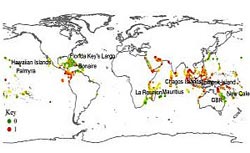Worldwide Map Identifies Important Coral Reefs Exposed to Stress

Wildlife Conservation Society<br>
The study, say the authors, will help to conserve some of the world’s most important coral reefs by identifying reef systems where biodiversity is high and stress is low, ecosystems where management has the best chance of success.
The paper appears online in journal PLoS One. The authors include: Joseph M. Maina of WCS and a doctoral student at Macquarie University, Sydney, Australia; Timothy R. McClanahan of WCS; Valentijn Venus of Netherlands Institute for Geo-Information Science and Earth Observation; Mebrahtu Ateweberhan of the University of Warwick; and Joshua Madin of Macquarie University.
“Coral reefs around the globe are under pressure from a variety of factors such as higher temperatures, sedimentation, and human-related activities such as fishing and coastal development,” said Joseph M. Maina, WCS conservationist and lead author on the study. “The key to effectively identifying where conservation efforts are most likely to succeed is finding reefs where high biodiversity and low stress intersect.”
Using a wide array of publicly available data sets from satellites and a branch of mathematics known as fuzzy logic, which can handle incomplete data on coral physiology and coral-environment interactions, the researchers grouped the world’s tropical coral reef systems into clusters based on the sum of their stress exposure grades and the factors that reinforce and reduce these stresses.
The first cluster of coral regions—Southeast Asia, Micronesia, the Eastern Pacific, and the central Indian Ocean—is characterized by high radiation stress (sea surface temperature, ultra-violet radiation, and doldrums weather patterns with little wind) and few stress-reducing factors (temperature variability and tidal amplitude). The group also includes corals in coastal waters of the Middle East and Western Australia (both regions have high scores for reinforcing stress factors such as sedimentation and phytoplankton).
The second cluster— including the Caribbean, Great Barrier Reef, Central Pacific, Polynesia, and the Western Indian Ocean—contained regions with moderate to high rates of exposure as well as high rates of reducing factors, such as large tides and temperature variability.
Overall, stress factors such as surface temperature, ultra-violet radiation, and doldrums were the most significant factors, ones that ecosystem management has no control over. What is controllable is the mitigation of human impacts that reinforce radiation stress and where managers decide to locate their protected areas.
“When radiation stress and high fishing are combined, the reefs have little chance of surviving climate change disturbances because they both work against the survival of corals that are the foundation of the coral reef ecosystem,” said Dr. Tim McClanahan, WCS Senior Conservationist and head of the society’s coral reef research and conservation program.
The authors recommend that the study results be used to formulate management strategies that would include activities such as fishing restrictions, the management of watersheds through improved agricultural practices, and reforestation of coastal watersheds that play a role in healthy coral systems.
“The study provides marine park and ecosystem managers with a plan for spatially managing the effectiveness of conservation and sustainability,” said Dr. Caleb McClennen, Director of the Wildlife Conservation Society’s Marine Program. “The information will help formulate more effective strategies to protect corals from climate change and lead to improved management of reef systems globally.”
The Macquarie University’s Higher Degree Research (HDR) and the Wildlife Conservation Society Marine Program contributed to the mapping project, with support from the John D. and Catherine T. MacArthur Foundation.
Media Contact
More Information:
http://www.wcs.orgAll latest news from the category: Ecology, The Environment and Conservation
This complex theme deals primarily with interactions between organisms and the environmental factors that impact them, but to a greater extent between individual inanimate environmental factors.
innovations-report offers informative reports and articles on topics such as climate protection, landscape conservation, ecological systems, wildlife and nature parks and ecosystem efficiency and balance.
Newest articles

High-energy-density aqueous battery based on halogen multi-electron transfer
Traditional non-aqueous lithium-ion batteries have a high energy density, but their safety is compromised due to the flammable organic electrolytes they utilize. Aqueous batteries use water as the solvent for…

First-ever combined heart pump and pig kidney transplant
…gives new hope to patient with terminal illness. Surgeons at NYU Langone Health performed the first-ever combined mechanical heart pump and gene-edited pig kidney transplant surgery in a 54-year-old woman…

Biophysics: Testing how well biomarkers work
LMU researchers have developed a method to determine how reliably target proteins can be labeled using super-resolution fluorescence microscopy. Modern microscopy techniques make it possible to examine the inner workings…





















